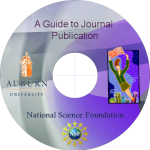

Special Issue Papers
What is a special issue? How does it differ from a regular issue? Should I send a paper to a special issue? How do I edit a special issue?
A special issue is an issue of an ongoing journal that is devoted to a specific topic. This is usually a technical topic but could be an issue memorializing a recently deceased leader in the field or could be a collection of superior papers from a recent conference or workshop. The theme is always announced in the "Call for Papers" for the special issue. Normally, the special issue will have a short title and the Call will specify more definitively the types of papers that are sought for the special issue. The Call will also include the timeframe and the special issue editors.
Special issues differ from regular issues in several important ways. First, they are confined to the stated theme of the special issue. Second, the editors are almost always not the regular editors of the journal. Rather, they are experts in the theme of the special issue and may include members on the journal's editorial board. These special issue editors take care of the review process, that is, choose reviewers, make outcome decisions, etc. Third, there is a specific (and usually ambitious) timeframe for submissions, reviews and revisions. Fourth, the number of pages (and therefore of papers) are set by the volume's limit. Therefore, competition for acceptance is likely to be different than the regular issues of the journal. Competition will depend on the other papers submitted for consideration for the special issue.
Should you consider a special issue? Definitely - if you have a paper that fits the theme. The good aspect of special issues for junior academics is that there is a specific timeframe that is usually accelerated from the normal one for that journal. Therefore, your time for a decision and time to print (for acceptances) are favorable. The fact that the issue will be a compilation of good papers on the theme means that the chances of your paper being read by those interested in this theme is high. In other words, the exposure that your paper will get, once in print, may be greatly enhanced. Another aspect, which can turn out favorable or not, is that the competition depends largely on how many other papers are submitted for the special issue and their quality. If it is more than expected, then your paper could be rejected even if it would normally make it to that journal. If it is less than expected, then the acceptance rate of the special issue may be higher than normally found in that journal. It is impossible (or almost impossible) to ascertain this aspect prior to submission. A final consideration is whether you or your co-author(s) have a connection to any of the special issue editors. While this may not help your review process, you can often get more information regarding the number of submissions and allowable papers.
You may be wondering how you can edit a special issue. This is certainly possible as a junior academic especially if you team with one or more senior academics (your advisor, perhaps?). A team for a special issue would be editors (usually two to three) who come up with a thematic idea that is appropriate for the target journal. They send a proposal to the editor in chief of the journal giving the proposed theme, timetable, number of papers, reviewing process, etc. The proposal is accepted, rejected or modified during a negotiation process. A "Call for Papers" is developed and published in the journal. This is also distributed on relevant internet listservs and websites, and at relevant conferences. As the papers come in, the special issue editors decide if these papers fit the issue - rejecting those that don't and sending the rest out for review. After the review period, the editors need to sort out the number of papers (or published pages) to accept or ask for revisions. They then handle the revision process (which is usually quite accelerated due to the time deadlines of publishing the special issue). The special issue editors choose the final set and order of papers for the issue and make sure that the papers are in final form, then transmit the group to the publisher. Often a special issue editor will author or co-author a paper that appears in his/her own special issue. This is done by having one of the other special issue editors handle the submission's review process. The special issue editors will normally write a short (one to three pages) introduction to the special issue, which appears at the beginning of the special issue prior to the papers.
Note that a special issue may not be a stand alone physical issue of the journal. Sometimes, a "special issue" is given only a portion of that issue of the journal. However, the special issue, if not stand alone, is always clearly separate from other papers that might appear in that issue.
